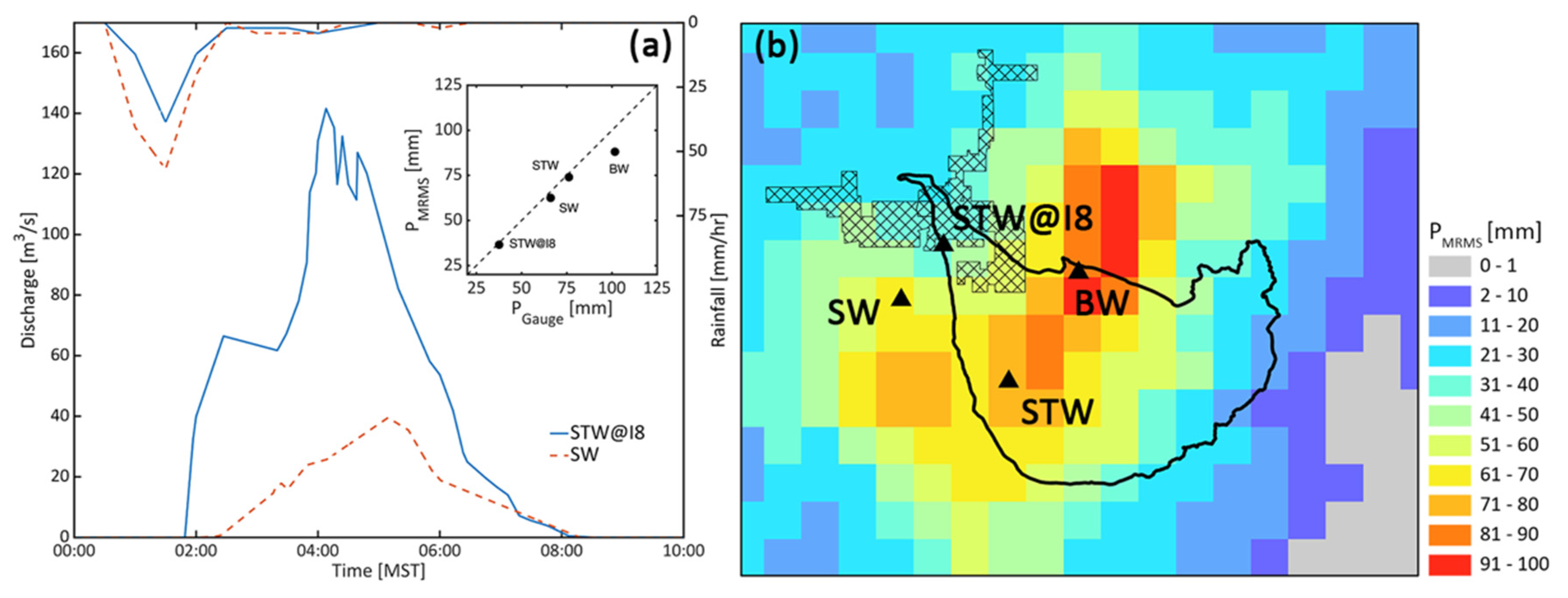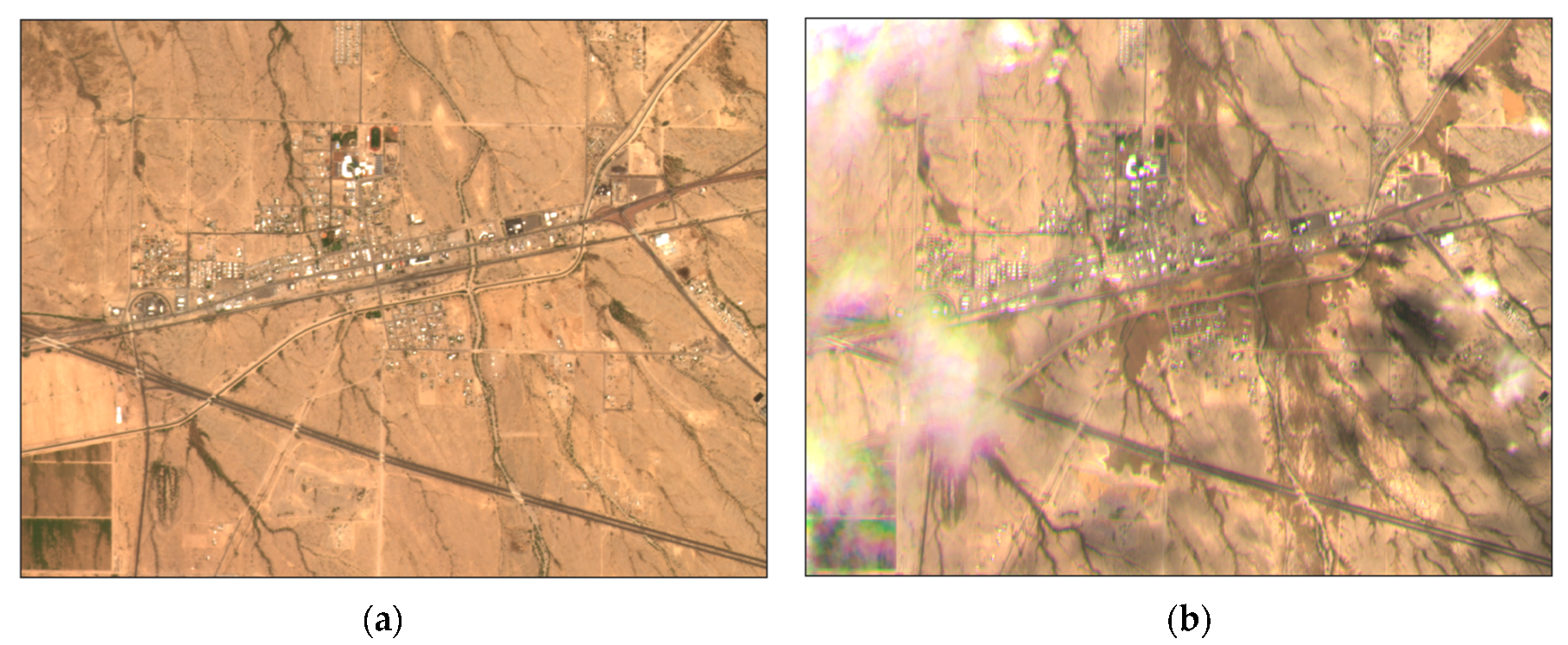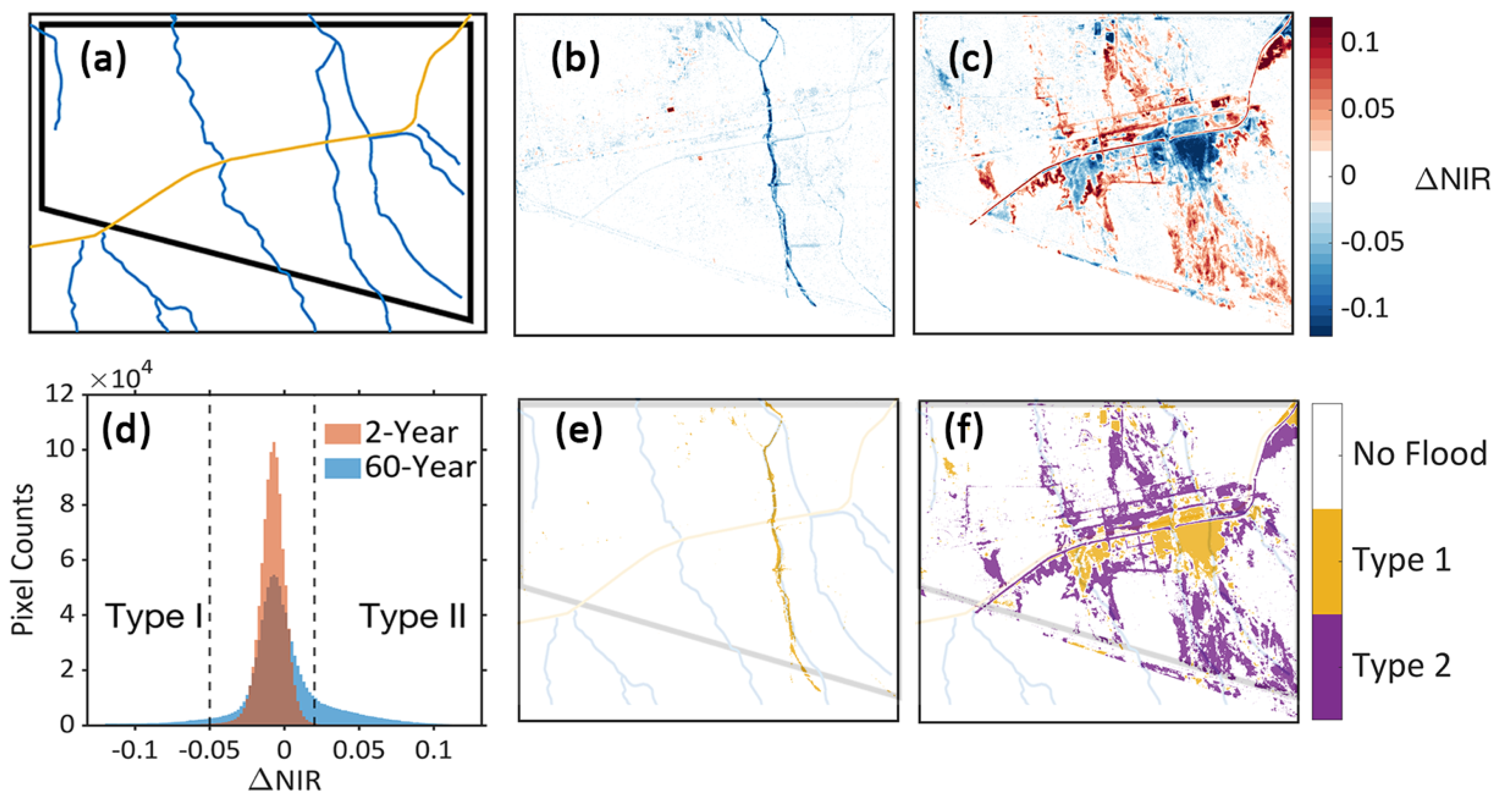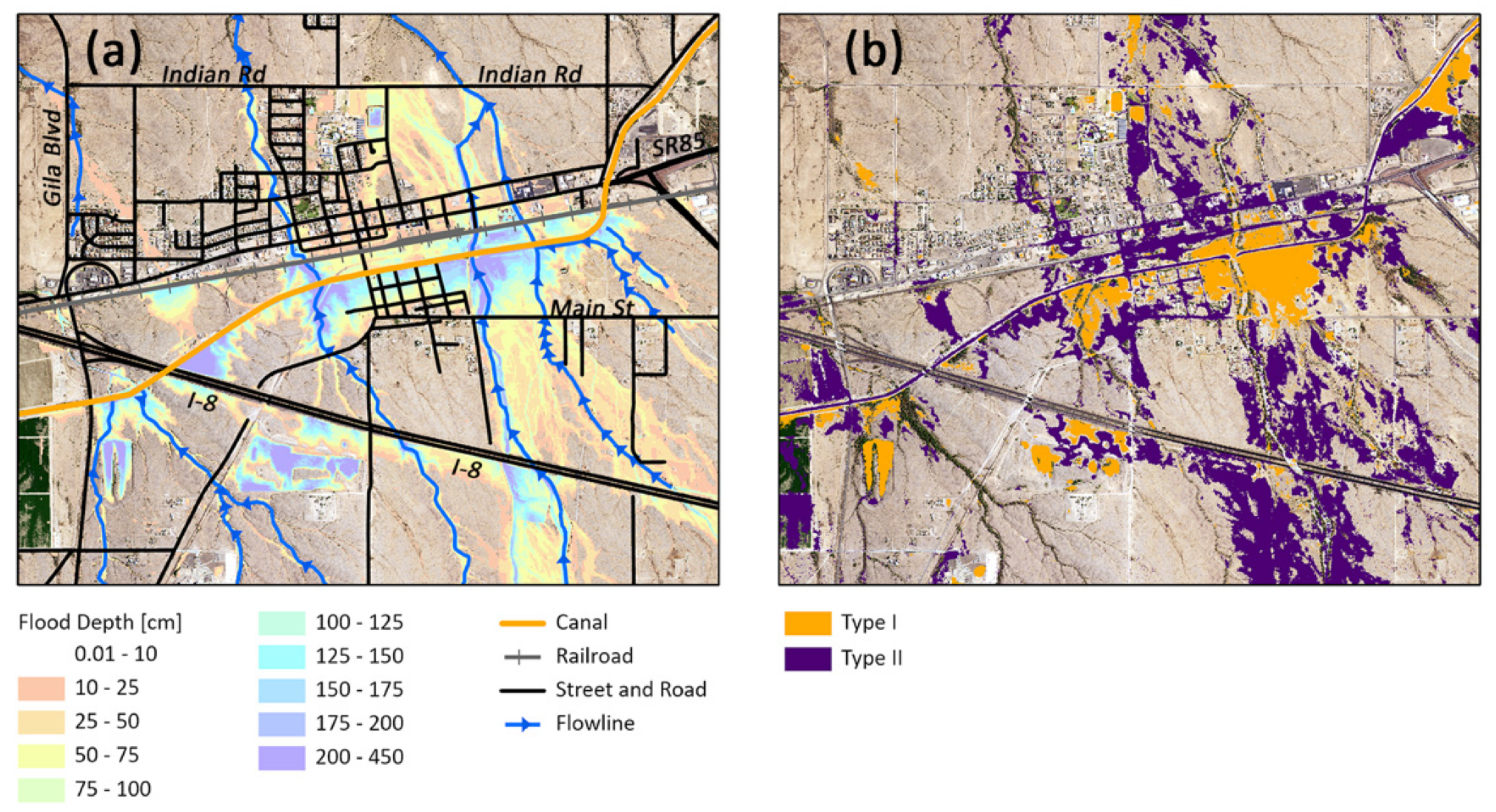Mapping Flash Flood Hazards in Arid Regions Using CubeSats
Abstract
:1. Introduction
2. Datasets and Methodology
2.1. Study Area
2.2. 13–14 August 2021 Flash Flood Event
2.3. Hydrometeorological Data
2.4. PlanetScope Imagery
2.5. Flood Extent Mapping
3. Results
3.1. Hydrometeorological Event
3.2. Flood Mapping from CubeSat RGB Imagery
3.3. Flood Mapping from CubeSat NIR Imagery
4. Discussion
4.1. Hydrometeorological Hazard Detection Using CubeSats
4.2. Potential Applications for Post-Flood Analyses in Arid Regions
4.3. Limitations and Uncertainties
5. Conclusions
Author Contributions
Funding
Data Availability Statement
Acknowledgments
Conflicts of Interest
References
- Weather Related Fatality and Injury Statistics. Available online: https://www.weather.gov/hazstat/ (accessed on 21 July 2022).
- Donat, M.G.; Lowry, A.L.; Alexander, L.; O’Gorman, P.A.; Maher, N. More Extreme Precipitation in the World’s Dry and Wet Regions. Nat. Clim. Change 2016, 6, 508–513. [Google Scholar] [CrossRef]
- Papalexiou, S.M.; Montanari, A. Global and Regional Increase of Precipitation Extremes Under Global Warming. Water Resour. Res. 2019, 55, 4901–4914. [Google Scholar] [CrossRef]
- Tellman, B.; Sullivan, J.A.; Kuhn, C.; Kettner, A.J.; Doyle, C.S.; Brakenridge, G.R.; Erickson, T.A.; Slayback, D.A. Satellite Imaging Reveals Increased Proportion of Population Exposed to Floods. Nature 2021, 596, 80–86. [Google Scholar] [CrossRef] [PubMed]
- Chester, M.; Allenby, B. Toward Adaptive Infrastructure: Flexibility and Agility in a Non-Stationarity Age. Sustain. Resilient Infrastruct. 2019, 4, 173–191. [Google Scholar] [CrossRef]
- Chester, M.; Underwood, B.S.; Samaras, C. Keeping Infrastructure Reliable under Climate Uncertainty. Nat. Clim. Change 2020, 10, 488–490. [Google Scholar] [CrossRef]
- Eakin, H.; Bojórquez-Tapia, L.A.; Janssen, M.A.; Georgescu, M.; Manuel-Navarrete, D.; Vivoni, E.R.; Escalante, A.E.; Baeza-Castro, A.; Mazari-Hiriart, M.; Lerner, A.M. Urban Resilience Efforts Must Consider Social and Political Forces. Proc. Natl. Acad. Sci. USA 2017, 114, 186–189. [Google Scholar] [CrossRef] [PubMed]
- Tellman, B.; Schank, C.; Schwarz, B.; Howe, P.D.; de Sherbinin, A. Using Disaster Outcomes to Validate Components of Social Vulnerability to Floods: Flood Deaths and Property Damage across the USA. Sustainability 2020, 12, 6006. [Google Scholar] [CrossRef]
- Ivanov, V.Y.; Xu, D.; Dwelle, M.C.; Sargsyan, K.; Wright, D.B.; Katopodes, N.; Kim, J.; Tran, V.N.; Warnock, A.; Fatichi, S.; et al. Breaking Down the Computational Barriers to Real-Time Urban Flood Forecasting. Geophys. Res. Lett. 2021, 48, e2021GL093585. [Google Scholar] [CrossRef]
- Vivoni, E.R.; Entekhabi, D.; Hoffman, R.N. Error Propagation of Radar Rainfall Nowcasting Fields through a Fully Distributed Flood Forecasting Model. J. Appl. Meteorol. Climatol. 2007, 46, 932–940. [Google Scholar] [CrossRef]
- Vivoni, E.R.; Entekhabi, D.; Bras, R.L.; Ivanov, V.Y.; van Horne, M.P.; Grassotti, C.; Hoffman, R.N. Extending the Predictability of Hydrometeorological Flood Events Using Radar Rainfall Nowcasting. J. Hydrometeorol. 2006, 7, 660–677. [Google Scholar] [CrossRef]
- Demir, I.; Krajewski, W.F. Towards an Integrated Flood Information System: Centralized Data Access, Analysis, and Visualization. Environ. Model. Softw. 2013, 50, 77–84. [Google Scholar] [CrossRef]
- Yatheendradas, S.; Wagener, T.; Gupta, H.; Unkrich, C.; Goodrich, D.; Schaffner, M.; Stewart, A. Understanding Uncertainty in Distributed Flash Flood Forecasting for Semiarid Regions. Water Resour. Res. 2008, 44, W05619. [Google Scholar] [CrossRef]
- Smith, J.A.; Baeck, M.L.; Yang, L.; Signell, J.; Morin, E.; Goodrich, D.C. The Paroxysmal Precipitation of the Desert: Flash Floods in the Southwestern U.S. Water Resour. Res. 2019, 55, 10218–10247. [Google Scholar] [CrossRef]
- Higgins, R.W.; Yao, Y.; Wang, X.L. Influence of the North American Monsoon System on the U.S. Summer Precipitation Regime. J. Clim. 1997, 10, 2600–2622. [Google Scholar] [CrossRef]
- Higgins, R.W.; Chen, Y.; Douglas, A.V. Interannual Variability of the North American Warm Season Precipitation Regime. J. Clim. 1999, 12, 653–680. [Google Scholar] [CrossRef]
- Gochis, D.J.; Brito-Castillo, L.; Shuttleworth, W.J. Hydroclimatology of the North American Monsoon Region in Northwest Mexico. J. Hydrol. 2006, 316, 53–70. [Google Scholar] [CrossRef]
- Yang, L.; Smith, J.; Baeck, M.L.; Morin, E. Flash Flooding in Arid/Semiarid Regions: Climatological Analyses of Flood-Producing Storms in Central Arizona during the North American Monsoon. J. Hydrometeorol. 2019, 20, 1449–1471. [Google Scholar] [CrossRef]
- Griffiths, P.G.; Magirl, C.S.; Webb, R.H.; Pytlak, E.; Troch, P.A.; Lyon, S.W. Spatial Distribution and Frequency of Precipitation during an Extreme Event: July 2006 Mesoscale Convective Complexes and Floods in Southeastern Arizona. Water Resour. Res. 2009, 45, W07419. [Google Scholar] [CrossRef]
- Magirl, C.S.; Webb, R.H.; Schaffner, M.; Lyon, S.W.; Griffiths, P.G.; Shoemaker, C.; Unkrich, C.L.; Yatheendradas, S.; Troch, P.A.; Pytlak, E.; et al. Impact of Recent Extreme Arizona Storms. Eos Trans. Am. Geophys. Union 2007, 88, 191–193. [Google Scholar] [CrossRef]
- Mascaro, G. On the Distributions of Annual and Seasonal Daily Rainfall Extremes in Central Arizona and Their Spatial Variability. J. Hydrol. 2018, 559, 266–281. [Google Scholar] [CrossRef]
- Vivoni, E.R.; Bowman, R.S.; Wyckoff, R.L.; Jakubowski, R.T.; Richards, K.E. Analysis of a Monsoon Flood Event in an Ephemeral Tributary and Its Downstream Hydrologic Effects. Water Resour. Res. 2006, 42, W03404. [Google Scholar] [CrossRef]
- Morin, E.; Goodrich, D.C.; Maddox, R.A.; Gao, X.; Gupta, H.; Sorooshian, S. Spatial Patterns in Thunderstorm Rainfall Events and Their Coupling with Watershed Hydrological Response. Adv. Water Resour. 2006, 29, 843–860. [Google Scholar] [CrossRef]
- McPhillips, L.E.; Earl, S.R.; Hale, R.L.; Grimm, N.B. Urbanization in Arid Central Arizona Watersheds Results in Decreased Stream Flashiness. Water Resour. Res. 2019, 55, 9436–9453. [Google Scholar] [CrossRef]
- Yang, L.; Smith, J.; Niyogi, D. Urban Impacts on Extreme Monsoon Rainfall and Flooding in Complex Terrain. Geophys. Res. Lett. 2019, 46, 5918–5927. [Google Scholar] [CrossRef]
- Helmrich, A.M.; Ruddell, B.L.; Bessem, K.; Chester, M.; Chohan, N.; Doerry, E.; Eppinger, J.; Garcia, M.; Goodall, J.L.; Lowry, C.; et al. Opportunities for Crowdsourcing in Urban Flood Monitoring. Environ. Model. Softw. 2021, 143, 105124. [Google Scholar] [CrossRef]
- Morrison, R.B.; Cooley, M.E. Assessment of flood damage in Arizona by means of ERTS-1 imagery. In NASA. Goddard Space Flight Center Symp. on Significant Results Obtained from the ERTS-1, Vol. 1, Sect. A and B; No. PAPER-W6; NASA: Washington DC, USA, 1973. [Google Scholar]
- Rango, A.; Salomonson, V.V. Regional Flood Mapping from Space. Water Resour. Res. 1974, 10, 473–484. [Google Scholar] [CrossRef]
- Alsdorf, D.E.; Rodríguez, E.; Lettenmaier, D.P.; Alsdorf, C.; Rodríguez, E.; Lettenmaier, D.P. Measuring Surface Water from Space. Rev. Geophys. 2007, 45, 2002. [Google Scholar] [CrossRef]
- Wang, Z.; Vivoni, E.R. Detecting Streamflow in Dryland Rivers Using CubeSats. Geophys. Res. Lett. 2022, 49, e2022GL098729. [Google Scholar] [CrossRef]
- Goodrich, D.C.; Lane, L.J.; Shillito, R.M.; Miller, S.N.; Syed, K.H.; Woolhiser, D.A. Linearity of Basin Response as a Function of Scale in a Semiarid Watershed. Water Resour. Res. 1997, 33, 2951–2965. [Google Scholar] [CrossRef]
- Roy, D.P.; Huang, H.; Houborg, R.; Martins, V.S. A Global Analysis of the Temporal Availability of PlanetScope High Spatial Resolution Multi-Spectral Imagery. Remote Sens. Environ. 2021, 264, 112586. [Google Scholar] [CrossRef]
- Frazier, A.E.; Hemingway, B.L. A Technical Review of Planet Smallsat Data: Practical Considerations for Processing and Using PlanetScope Imagery. Remote Sens. 2021, 13, 3930. [Google Scholar] [CrossRef]
- Planet Team. Planet Application Program Interface. In Space for Life on Earth; Planet Team: San Francisco, CA, USA, 2017; Available online: https://api.planet.com (accessed on 12 September 2021).
- 2021 Monsoon Review. Available online: https://www.weather.gov/psr/2021MonsoonReview (accessed on 23 July 2022).
- Flood Control District of Maricopa County. Storm Report: August 12–14, 2021. Available online: https://alert.fcd.maricopa.gov/alert/WY21/StormRpt_08_12-14_2021.pdf (accessed on 23 July 2022).
- County Coordinating Recovery after Flooding in Gila Bend|KJZZ. Available online: https://kjzz.org/content/1708901/department-emergency-management-coordinating-recovery-efforts-after-flooding-gila (accessed on 23 July 2022).
- At Least 2 Dead, 30 Rescued after Severe Flooding in Gila Bend; State of Emergency Declared. Available online: https://www.fox10phoenix.com/news/at-least-2-dead-after-monsoon-flooding-sweeps-through-gila-bend-state-of-emergency-declared (accessed on 31 July 2022).
- Office of the Arizona Governor Doug Ducey. Available online: https://azgovernor.gov/ (accessed on 30 July 2022).
- Zhang, J.; Howard, K.; Langston, C.; Kaney, B.; Qi, Y.; Tang, L.; Grams, H.; Wang, Y.; Cockcks, S.; Martinaitis, S.; et al. Multi-Radar Multi-Sensor (MRMS) Quantitative Precipitation Estimation: Initial Operating Capabilities. Bull. Am. Meteorol. Soc. 2016, 97, 621–638. [Google Scholar] [CrossRef]
- Vivoni, E.R.; Kindler, M.; Wang, Z.; Pérez-Ruiz, E.R. Abiotic Mechanisms Drive Enhanced Evaporative Losses under Urban Oasis Conditions. Geophys. Res. Lett. 2020, 47, e2020GL090123. [Google Scholar] [CrossRef]
- Kindler, M.; Vivoni, E.R.; Pérez-Ruiz, E.R.; Wang, Z. Water Conservation Potential of Modified Turf Grass Irrigation in Urban Parks of Phoenix, Arizona. Ecohydrology 2021, 15, e2399. [Google Scholar] [CrossRef]
- Kääb, A.; Altena, B.; Mascaro, J. River-Ice and Water Velocities Using the Planet Optical Cubesat Constellation. Hydrol. Earth Syst. Sci. 2019, 23, 4233–4247. [Google Scholar] [CrossRef]
- Cooley, S.W.; Smith, L.C.; Stepan, L.; Mascaro, J. Tracking Dynamic Northern Surface Water Changes with High-Frequency Planet CubeSat Imagery. Remote Sens. 2017, 9, 1306. [Google Scholar] [CrossRef]
- Cooley, S.W.; Smith, L.C.; Ryan, J.C.; Pitcher, L.H.; Pavelsky, T.M. Arctic-Boreal Lake Dynamics Revealed Using CubeSat Imagery. Geophys. Res. Lett. 2019, 46, 2111–2120. [Google Scholar] [CrossRef]
- Understanding Planet Instruments. Available online: https://developers.planet.com/docs/apis/data/sensors/ (accessed on 1 July 2021).
- Maddox, R.A.; McCollum, D.M.; Howard, K.W. Large-Scale Patterns Associated with Severe Summertime Thunderstorms over Central Arizona. Weather Forecast. 1995, 10, 763–778. [Google Scholar] [CrossRef]
- NWS Weather Prediction Center WPC Met Watch: #0780 (2021). Available online: https://www.wpc.ncep.noaa.gov/metwatch/metwatch_mpd_multi.php?md=780&yr=2021 (accessed on 20 July 2022).
- NWS Weather Prediction Center WPC Met Watch: #0781 (2021). Available online: https://www.wpc.ncep.noaa.gov/metwatch/metwatch_mpd_multi.php?md=781&yr=2021 (accessed on 20 July 2022).
- Okin, G.S.; de Las Heras, M.M.; Saco, P.M.; Throop, H.L.; Vivoni, E.R.; Parsons, A.J.; Wainwright, J.; Peters, D.P.C. Connectivity in Dryland Landscapes: Shifting Concepts of Spatial Interactions. Front. Ecol. Environ. 2015, 13, 20–27. [Google Scholar] [CrossRef]
- McCabe, M.F.; Aragon, B.; Houborg, R.; Mascaro, J. CubeSats in Hydrology: Ultrahigh-Resolution Insights into Vegetation Dynamics and Terrestrial Evaporation. Water Resour. Res. 2017, 53, 10017–10024. [Google Scholar] [CrossRef] [Green Version]
- Fatichi, S.; Vivoni, E.R.; Ogden, F.L.; Ivanov, V.Y.; Mirus, B.; Gochis, D.; Downer, C.W.; Camporese, M.; Davison, J.H.; Ebel, B.; et al. An Overview of Current Applications, Challenges, and Future Trends in Distributed Process-Based Models in Hydrology. J. Hydrol. 2016, 537, 45–60. [Google Scholar] [CrossRef]
- Shrestha, A.; Mascaro, G.; Garcia, M. Effects of Stormwater Infrastructure Data Completeness and Model Resolution on Urban Flood Modeling. J. Hydrol. 2022, 607, 127498. [Google Scholar] [CrossRef]
- Hjelmstad, A.; Shrestha, A.; Garcia, M.; Mascaro, G. Propagation of Radar Rainfall Uncertainties into Urban Pluvial Flood Modeling during the North American Monsoon. Hydrol. Sci. J. 2021, 66, 2232–2248. [Google Scholar] [CrossRef]
- Erena, S.H.; Worku, H.; de Paola, F. Flood Hazard Mapping Using FLO-2D and Local Management Strategies of Dire Dawa City, Ethiopia. J. Hydrol. Reg. Stud. 2018, 19, 224–239. [Google Scholar] [CrossRef]
- Rosser, J.F.; Leibovici, D.G.; Jackson, M.J. Rapid Flood Inundation Mapping Using Social Media, Remote Sensing and Topographic Data. Nat. Hazards 2017, 87, 103–120. [Google Scholar] [CrossRef]
- See, L. A Review of Citizen Science and Crowdsourcing in Applications of Pluvial Flooding. Front. Earth Sci. 2019, 7, 44. [Google Scholar] [CrossRef]
- Petersson, L.; ten Veldhuis, M.C.; Verhoeven, G.; Kapelan, Z.; Maholi, I.; Winsemius, H.C. Community Mapping Supports Comprehensive Urban Flood Modeling for Flood Risk Management in a Data-Scarce Environment. Front. Earth Sci. 2020, 8, 304. [Google Scholar] [CrossRef]
- Collins, E.L.; Sanchez, G.M.; Terando, A.; Stillwell, C.C.; Mitasova, H.; Sebastian, A.; Meentemeyer, R.K. Predicting Flood Damage Probability across the Conterminous United States. Environ. Res. Lett. 2022, 17, 034006. [Google Scholar] [CrossRef]
- Tellman, B.; Lall, U.; Islam, A.K.M.S.; Bhuyan, M.A. Regional Index Insurance Using Satellite-Based Fractional Flooded Area. Earth’s Future 2022, 10, e2021EF002418. [Google Scholar] [CrossRef]
- Lin, L.; Di, L.; Yu, E.G.; Kang, L.; Shrestha, R.; Rahman, M.S.; Tang, J.; Deng, M.; Sun, Z.; Zhang, C.; et al. A Review of Remote Sensing in Flood Assessment. In Proceedings of the 2016 5th International Conference on Agro-Geoinformatics, Agro-Geoinformatics 2016, Tianjin, China, 18–20 July 2016. [Google Scholar] [CrossRef]
- Verpoorter, C.; Kutser, T.; Tranvik, L. Automated Mapping of Water Bodies Using Landsat Multispectral Data. Limnol. Oceanogr. Methods 2012, 10, 1037–1050. [Google Scholar] [CrossRef]





| Date | Rainfall [mm/day] | Hazards | Record Types |
|---|---|---|---|
| 13–15 August 1990 | 30 | Ponding along GBC and SR85 | Photos |
| 27 August 2013 | 38 | SR238 closed due to flooding | |
| 4 May 2015 | 14 | SR238 closed due to flooding | |
| 13–14 September 2015 | 51 | Trapped 8–10 cars and up to 30 passengers | Twitter, photos |
| Station Name | Abbr. | Dev. Type | Elevation (m) |
|---|---|---|---|
| Sand Tank Wash | STW | P | 354 |
| Sand Tank Wash @ I-8 | STW@I8 | P & Q | 232 |
| Sauceda Wash | SW | P & Q | 256 |
| Bender Wash | BW | P & Q | 366 |
Publisher’s Note: MDPI stays neutral with regard to jurisdictional claims in published maps and institutional affiliations. |
© 2022 by the authors. Licensee MDPI, Basel, Switzerland. This article is an open access article distributed under the terms and conditions of the Creative Commons Attribution (CC BY) license (https://creativecommons.org/licenses/by/4.0/).
Share and Cite
Wang, Z.; Vivoni, E.R. Mapping Flash Flood Hazards in Arid Regions Using CubeSats. Remote Sens. 2022, 14, 4218. https://doi.org/10.3390/rs14174218
Wang Z, Vivoni ER. Mapping Flash Flood Hazards in Arid Regions Using CubeSats. Remote Sensing. 2022; 14(17):4218. https://doi.org/10.3390/rs14174218
Chicago/Turabian StyleWang, Zhaocheng, and Enrique R. Vivoni. 2022. "Mapping Flash Flood Hazards in Arid Regions Using CubeSats" Remote Sensing 14, no. 17: 4218. https://doi.org/10.3390/rs14174218






